What were the laptops 20 years ago on the example of Toshiba libretto 100ct
I would like to talk today about such a wonderful device as Toshiba Libretto 100ct.
As you know, the first in the history of the laptop was the Grid Compass. He appeared in 1979 for the needs of NASA. Toshiba T1100, which appeared in 1985, also known as “the first mass portable PC on the market”, became the first laptop from Toshiba. It was distinguished by a high-quality monochrome LCD display with a resolution of 640x200, was equipped with a 4.77 MHz Intel 80C88 processor (Intel 8088 with reduced power consumption) and a floppy drive for 3.5-inch 720K diskettes. Since then, Toshiba has been at the forefront of the global notebook market.
By the end of the 90s, laptops were no longer as bulky as they were before, and Toshiba released, in my opinion, a revolutionary line of compact laptops - Libretto .
')
The first in this line was the model Libretto 20:

Brief specifications are as follows: AMD 486 DX4 75 MHz, 8 MB RAM (20 MB max.), 270 MB hard disk, 6.1 "TFT display.
The name of the line Libretto appeared for a reason: in translation from Italian, this word means “book” or “booklet”. Indeed, these laptops are the size of a regular book. My copy is no different. I got this device to me in an interesting way, from the city of Krasnoyarsk.

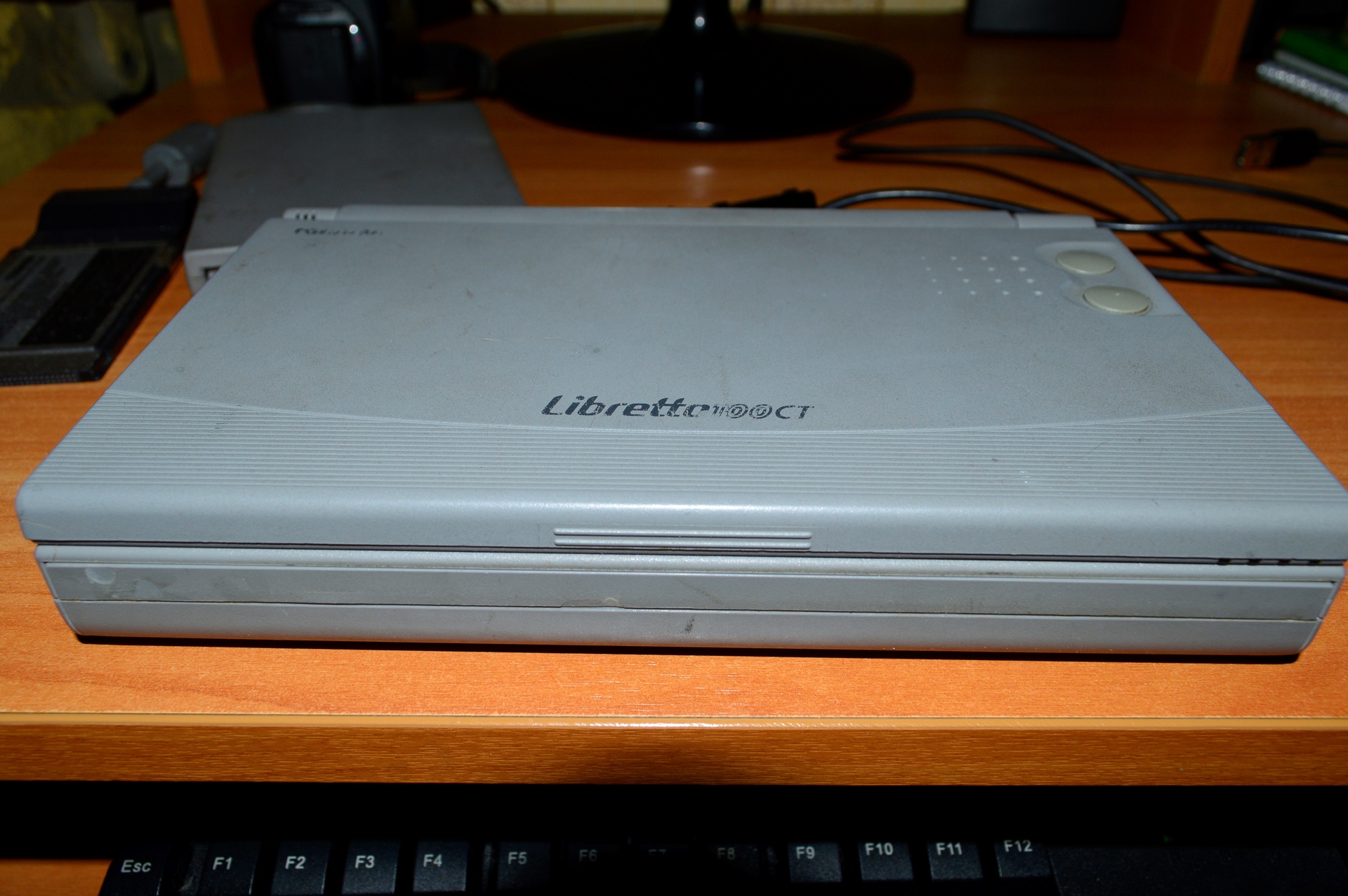

The dimensions of this Libretto microbook are 100, 210 x 132 x 35 mm - only 18 mm wider than previous models - and it weighs 950 g (against 840 - 850 g)
Characteristics of this device:
Processor: Intel Pentium 166Mhz w MMX
Memory (RAM): EDO32MByte
HDD: 2 GB
Video chip / memory: NeoMagic NM 2160 2 MB
Matrix / Resolution: TFT 7.1 / 800 * 600
Modem / Network: Optional PCMCIA
Sound: Yamaha OPL3 (16-bit stereo)
PCMCIA / CardBus: 2-CardBus / PC-Card, 1 ZV port
Other: PCMCIA FDD 3.5; IrDA (FIR) PS / 2 (Keyb or mouse); RS232; LPT (Bi-dir./ECP) Li-Ion 2.400Ah
At that time, pretty good performance. On board is already pre-installed Windows 98.
As you have already noticed, we are not accustomed to modern touchpad laptops. Instead, Toshiba has invented its cursor control system - a kind of joystick (as they themselves called - equipoint). It is located on the right side of the display:
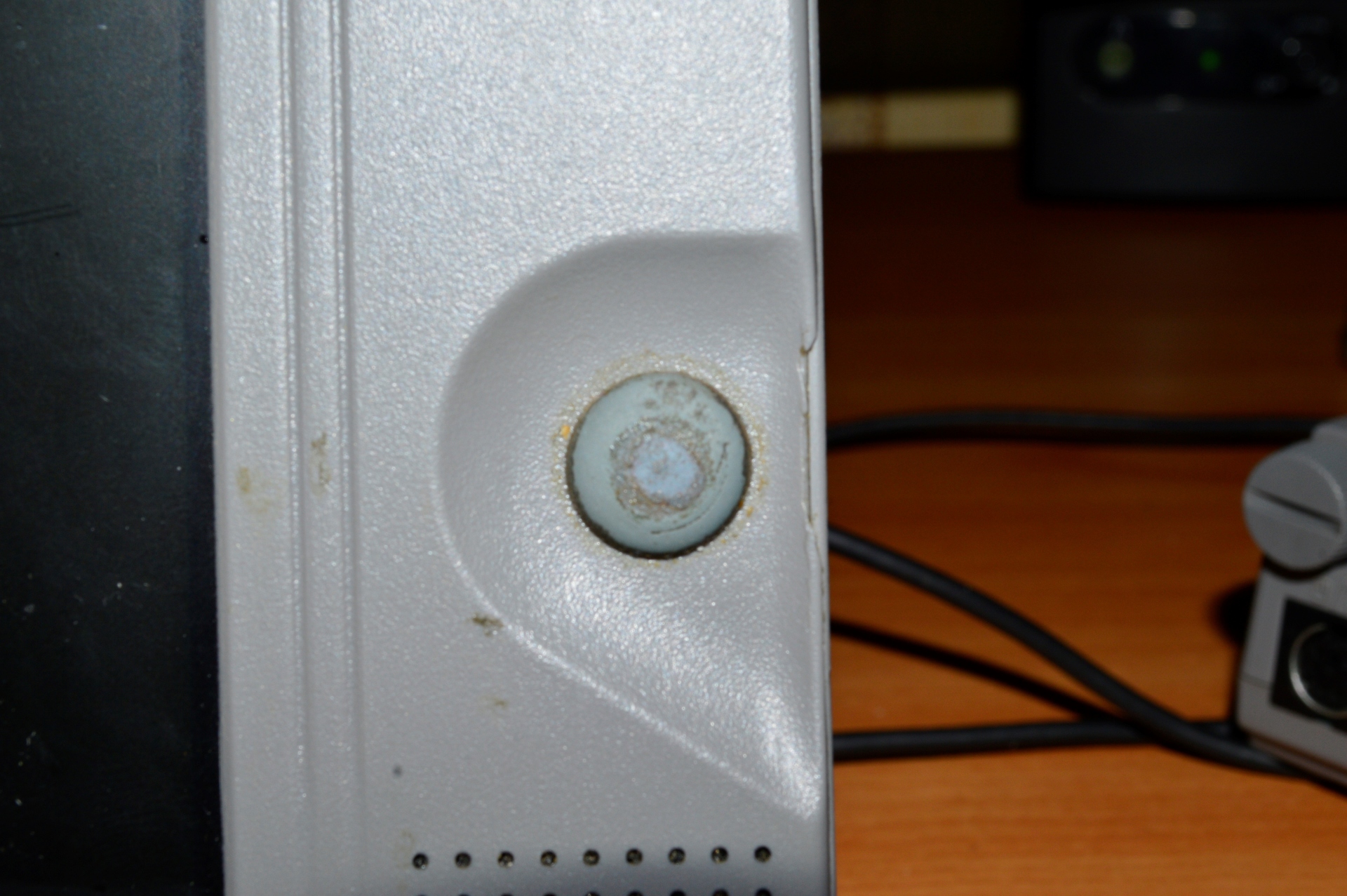
But the mouse buttons are on the reverse side:

I got a floppy disk drive, a port replicator, a PCMCIA modem (unfortunately, without an adapter for an ADSL cable) and a power supply, and without it.
On the right side we have two slots for PCMCIA cards and an infrared port:

It already supports both PCIMCA 16bit cards and CardBus 32bit standard cards, unlike Libretto 70ct, which only supported PCMCIA 16bit cards and had only one slot for them. On the back side, we have only 2.5 mm connectors for headphones and a microphone, levers for removing cards and a connector for the power supply.

We have nothing on the left side. But, thanks to the port replicator, which is connected via the connector located below the laptop, we get several of the connectors we need - this is a COM port, LPT port, VGA, PS \ 2. Nothing extra. There are also docking stations where the USB port is already present.
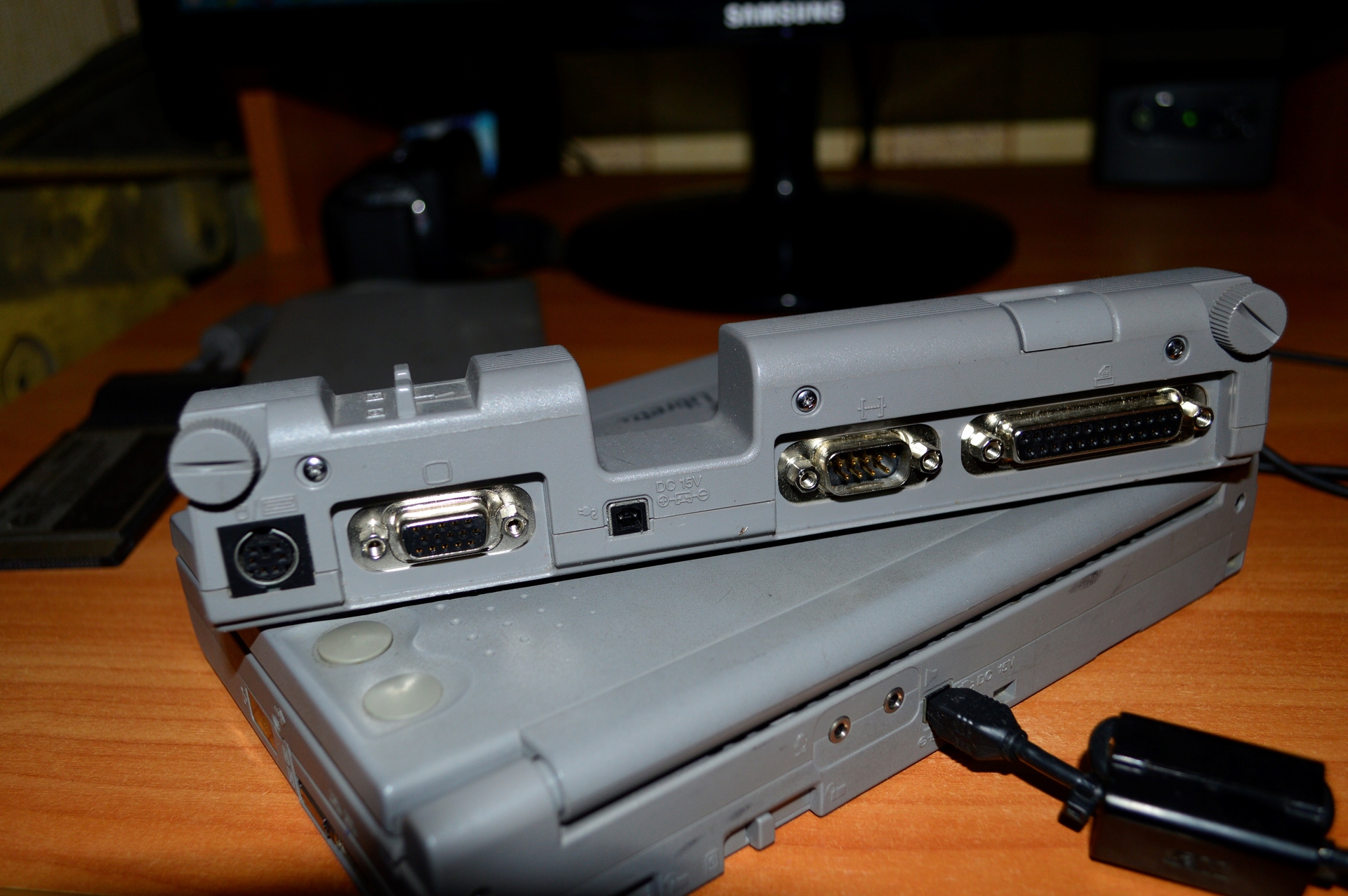
With him, he somehow becomes even more brutal:

Compared to the previous model, quite important changes have occurred in the 100ct model: the processor frequency has increased, the amount of RAM has increased, two slots for PCMCIA cards have appeared instead of one, a built-in microphone and a microphone connector have also appeared:


It is worth paying tribute to the manufacturer: for almost 20 years of the existence and operation of a laptop, only a small loop gap appeared. In modern laptops, however, the loops are loosened in less than two years, almost all laptops that have encountered have such a disease (or maybe this is all the work of the users themselves).
Another detail, unfortunately, over time, manufacturers refused - latches. Very handy thing, thanks to which the lid is securely fixed and does not open accidentally when it is not needed, but at the same time you can lift the lid without much effort.
What can you say about the keyboard: although it is rather small, it is quite convenient for her to type text, you only need to get used to it a little.
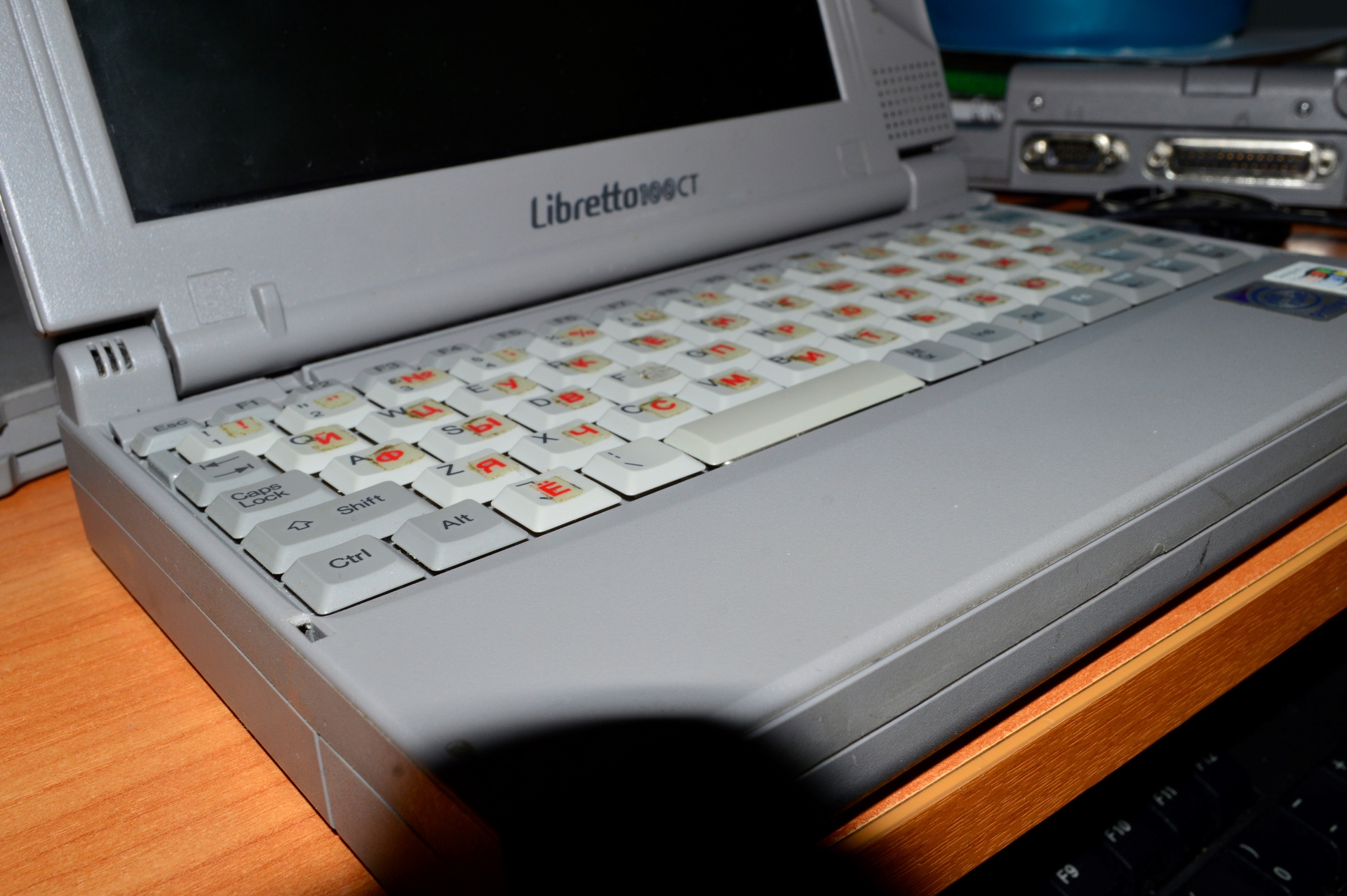
Toshiba also organized hibernation on this laptop, when, like at the OS level, this function appeared only in XP (if the memory does not change me), which means that even if the laptop is discharged, you will not lose all not saved files =)
The situation with the floppy disk drive is also interesting: the drivers from it are sewn up at the BIOS level, which allows booting from floppy disks, but does not fit other devices, including newer ones, has been tested by many people.
I think it is still possible for him to find an application even now (for example, it is convenient to write lectures on him). Of course, besides advantages, there are also disadvantages:
1. Low autonomy of work;
2. Lack of network carts, wifi adapter, dances with a tambourine are also needed in order for the PCMCIA wifi adapter to start under win98;
3. Lack of usb.
FDD:

Modem:
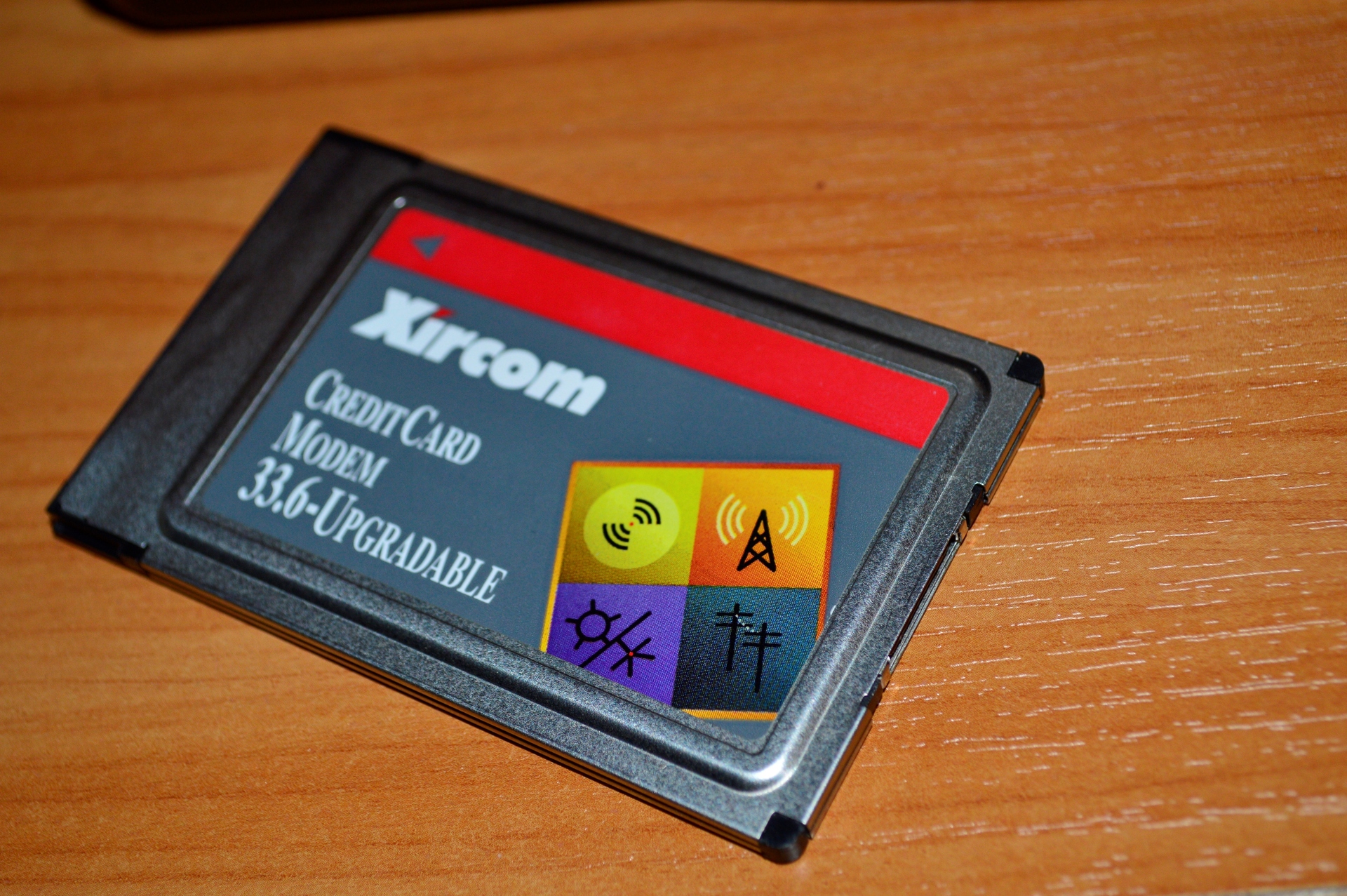
FAR:

PuTTy:
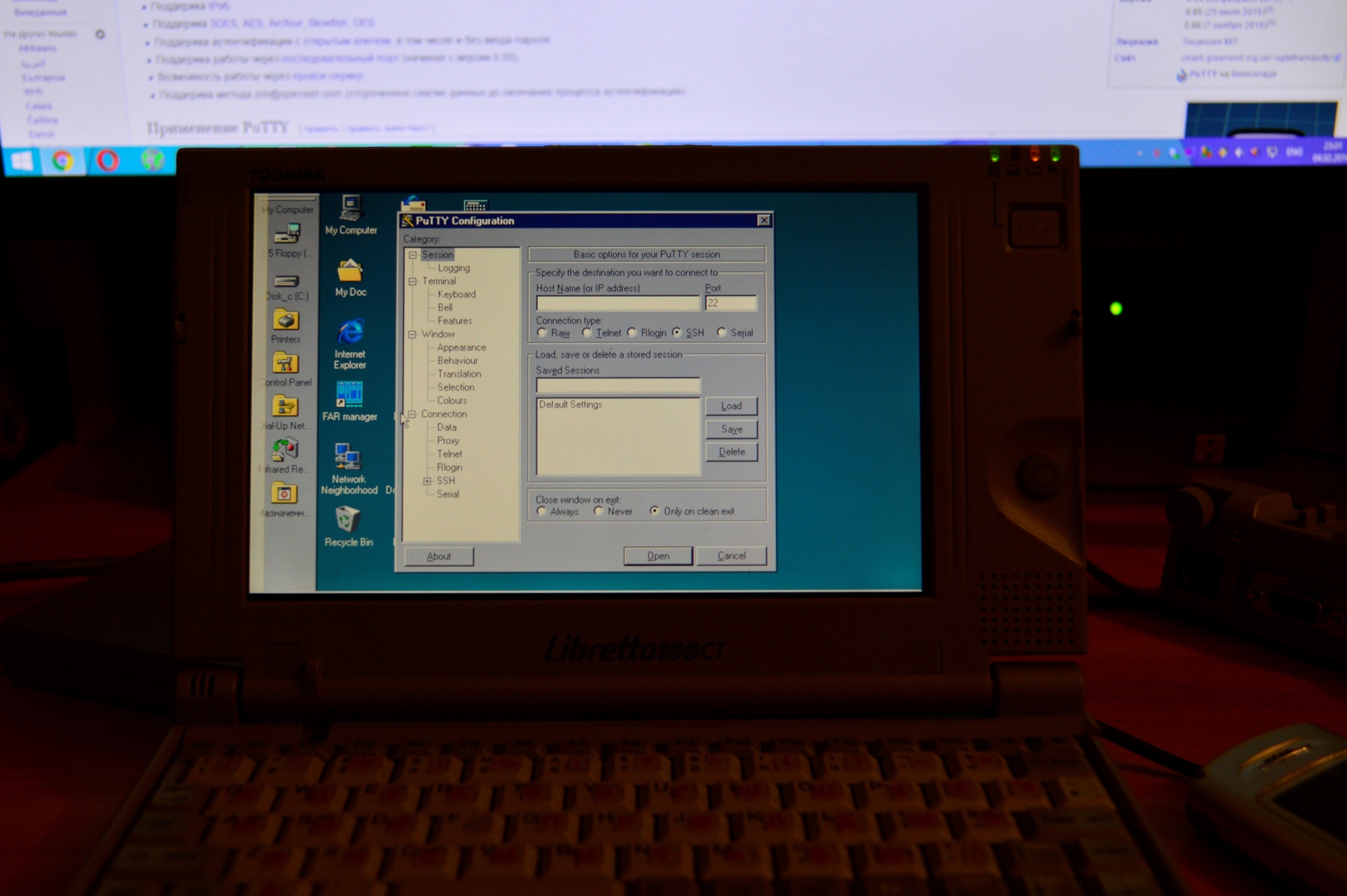
I would like to say thanks to one person who has a YouTube channel - Cyril Leifer. After watching his videos, I was very interested in the topic of old devices, and it was decided to collect the same things. There are already relatively old and not very devices: Samsung c100, Nokia n95.
I hope it was not boring. Thanks for stopping by and reading. With the advent of new devices I will continue to write.
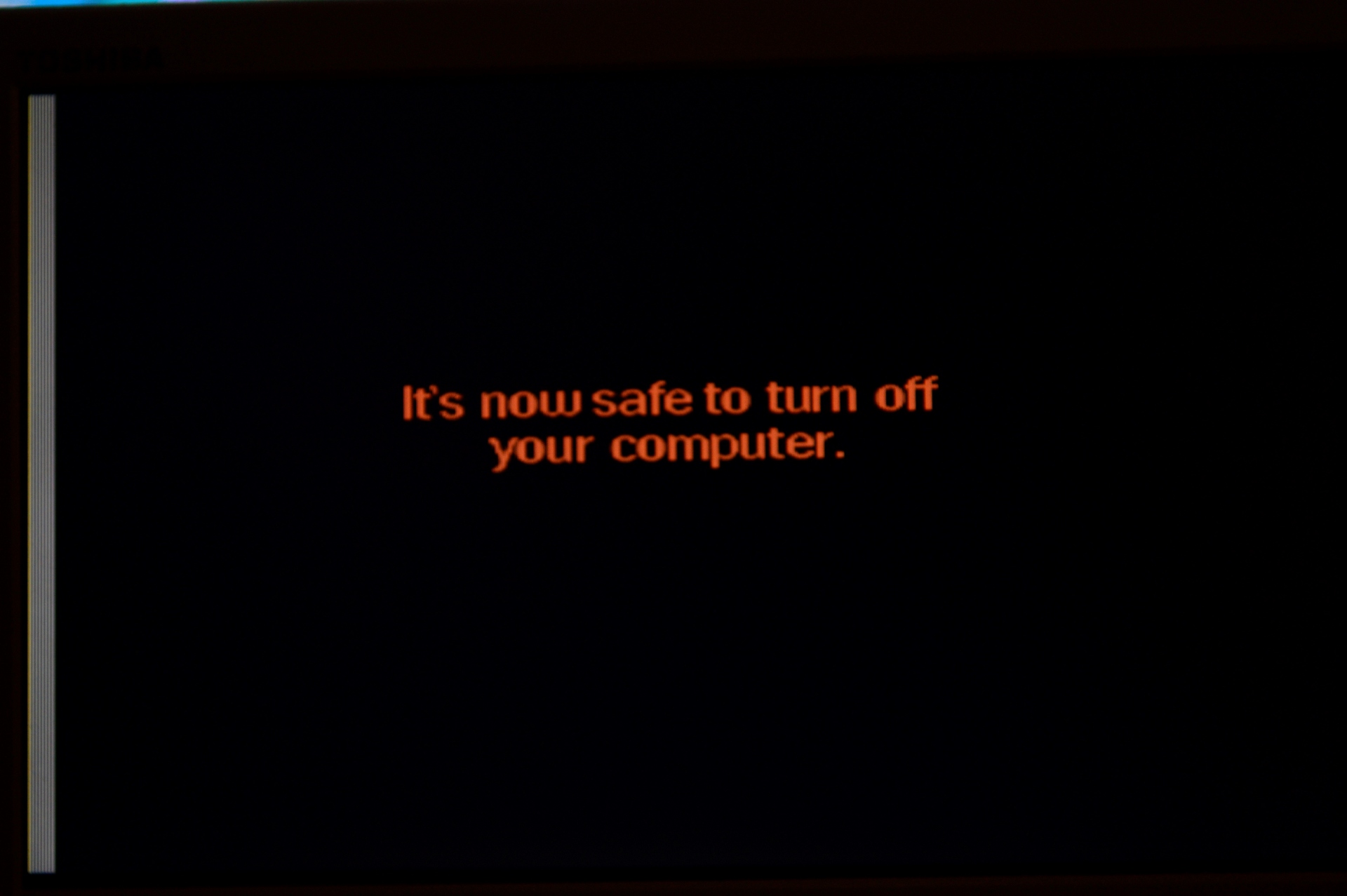
A bit of history
As you know, the first in the history of the laptop was the Grid Compass. He appeared in 1979 for the needs of NASA. Toshiba T1100, which appeared in 1985, also known as “the first mass portable PC on the market”, became the first laptop from Toshiba. It was distinguished by a high-quality monochrome LCD display with a resolution of 640x200, was equipped with a 4.77 MHz Intel 80C88 processor (Intel 8088 with reduced power consumption) and a floppy drive for 3.5-inch 720K diskettes. Since then, Toshiba has been at the forefront of the global notebook market.
By the end of the 90s, laptops were no longer as bulky as they were before, and Toshiba released, in my opinion, a revolutionary line of compact laptops - Libretto .
')
The first in this line was the model Libretto 20:

Brief specifications are as follows: AMD 486 DX4 75 MHz, 8 MB RAM (20 MB max.), 270 MB hard disk, 6.1 "TFT display.
The name of the line Libretto appeared for a reason: in translation from Italian, this word means “book” or “booklet”. Indeed, these laptops are the size of a regular book. My copy is no different. I got this device to me in an interesting way, from the city of Krasnoyarsk.
So proceed to the review
The dimensions of this Libretto microbook are 100, 210 x 132 x 35 mm - only 18 mm wider than previous models - and it weighs 950 g (against 840 - 850 g)
Characteristics of this device:
Processor: Intel Pentium 166Mhz w MMX
Memory (RAM): EDO32MByte
HDD: 2 GB
Video chip / memory: NeoMagic NM 2160 2 MB
Matrix / Resolution: TFT 7.1 / 800 * 600
Modem / Network: Optional PCMCIA
Sound: Yamaha OPL3 (16-bit stereo)
PCMCIA / CardBus: 2-CardBus / PC-Card, 1 ZV port
Other: PCMCIA FDD 3.5; IrDA (FIR) PS / 2 (Keyb or mouse); RS232; LPT (Bi-dir./ECP) Li-Ion 2.400Ah
At that time, pretty good performance. On board is already pre-installed Windows 98.
As you have already noticed, we are not accustomed to modern touchpad laptops. Instead, Toshiba has invented its cursor control system - a kind of joystick (as they themselves called - equipoint). It is located on the right side of the display:
But the mouse buttons are on the reverse side:
I got a floppy disk drive, a port replicator, a PCMCIA modem (unfortunately, without an adapter for an ADSL cable) and a power supply, and without it.
On the right side we have two slots for PCMCIA cards and an infrared port:
It already supports both PCIMCA 16bit cards and CardBus 32bit standard cards, unlike Libretto 70ct, which only supported PCMCIA 16bit cards and had only one slot for them. On the back side, we have only 2.5 mm connectors for headphones and a microphone, levers for removing cards and a connector for the power supply.
We have nothing on the left side. But, thanks to the port replicator, which is connected via the connector located below the laptop, we get several of the connectors we need - this is a COM port, LPT port, VGA, PS \ 2. Nothing extra. There are also docking stations where the USB port is already present.
With him, he somehow becomes even more brutal:
Compared to the previous model, quite important changes have occurred in the 100ct model: the processor frequency has increased, the amount of RAM has increased, two slots for PCMCIA cards have appeared instead of one, a built-in microphone and a microphone connector have also appeared:
It is worth paying tribute to the manufacturer: for almost 20 years of the existence and operation of a laptop, only a small loop gap appeared. In modern laptops, however, the loops are loosened in less than two years, almost all laptops that have encountered have such a disease (or maybe this is all the work of the users themselves).
Another detail, unfortunately, over time, manufacturers refused - latches. Very handy thing, thanks to which the lid is securely fixed and does not open accidentally when it is not needed, but at the same time you can lift the lid without much effort.
What can you say about the keyboard: although it is rather small, it is quite convenient for her to type text, you only need to get used to it a little.
Toshiba also organized hibernation on this laptop, when, like at the OS level, this function appeared only in XP (if the memory does not change me), which means that even if the laptop is discharged, you will not lose all not saved files =)
The situation with the floppy disk drive is also interesting: the drivers from it are sewn up at the BIOS level, which allows booting from floppy disks, but does not fit other devices, including newer ones, has been tested by many people.
I think it is still possible for him to find an application even now (for example, it is convenient to write lectures on him). Of course, besides advantages, there are also disadvantages:
1. Low autonomy of work;
2. Lack of network carts, wifi adapter, dances with a tambourine are also needed in order for the PCMCIA wifi adapter to start under win98;
3. Lack of usb.
FDD:
Modem:
Soft
FAR:
PuTTy:
I would like to say thanks to one person who has a YouTube channel - Cyril Leifer. After watching his videos, I was very interested in the topic of old devices, and it was decided to collect the same things. There are already relatively old and not very devices: Samsung c100, Nokia n95.
I hope it was not boring. Thanks for stopping by and reading. With the advent of new devices I will continue to write.
Source: https://habr.com/ru/post/390819/
All Articles